| |
|
All
Saints, Earsham
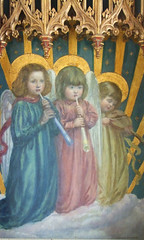 |
|
Like
neighbouring Ditchingham, Earsham is saved from
being mere suburbia by the way the lazy Waveney
sprawls, forcing water meadows between the
Suffolk town of Bungay and its Norfolk adherents.
Unlike Ditchingham, Earsham has a feel of
remoteness; it is neatly bypassed by the road
from Diss, and you wouldn't even know that Bungay
was there, the illusion is so complete. Mind you,
there are far worse towns than pretty Bungay of
which to find yourself a suburb.
While Earsham successfully retains the feel of a
small village, there can be no doubt that All
Saints presents itself as a big church. This
again is something of an illusion, sleight of
hand if you like; the nave is quite long, but
there are no aisles, no clerestory.
The chunky 14th century tower is surmounted by a
rather squat spire, one of few in East Anglia. It
is this, coupled with the substantial chancel,
that creates the feel of a sprawling building.
Stepping inside there is no doubt that length is
the over-riding feature of the structure, the
almost tunnel-like nave leading the eye into the
bright, majestic high Tractarianism of the
chancel. |
But before that, the font. Earsham has one of East
Anglia's thirty-odd seven sacrament fonts, but is rather
different from others I have seen in that it is slim,
with portrait-shaped reliefs. This require some
simplification in the iconography, the Last Rites and
Mass panels in particular being awkwardly squeezed into
their spaces, but there is no doubt that this font is a
most elegant example. The eighth 'odd panel out' is the
Crucifixion. The whole thing is in excellent condition,
and really deserves to be better known.
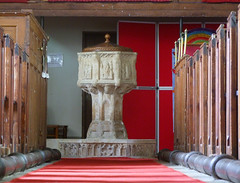
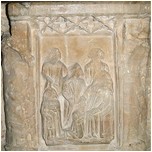 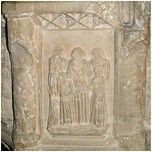
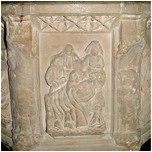 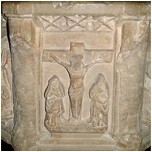
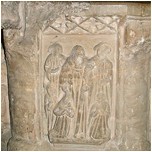 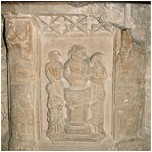
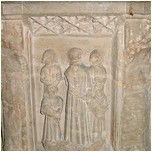 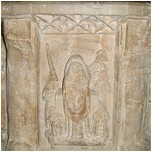
The
collection of foreign glass in the east window is
interesting. It was brought together here in 1810 by
Samuel Yarrington from the import warehouse of JC Hampp,
as at a number of churches on this side of Norfolk. The
most striking are three continental panels, one depicting
Joseph giving corn to his brothers, another showing the
Last Rites from the seven sacraments sequence. The most
curious appears, at first, to show the Annunciation - but
the woman at the prayer desk with her back to the angel
is clearly not Mary, but probably a donor. The
inscription alludes to the part in the Gospel of St Luke
where Elizabeth is told she is to become a mother, and so
it was probably originally associated with a scene of St
John the Baptist.
 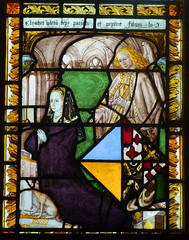 
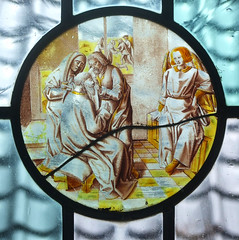 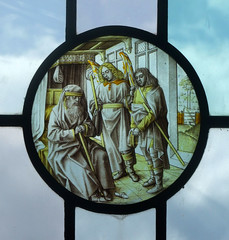 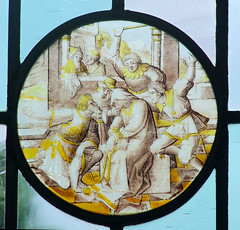 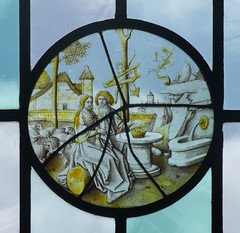  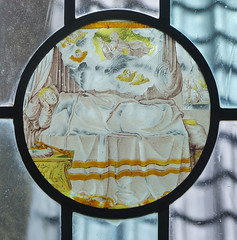 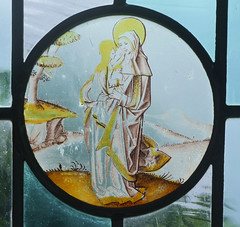 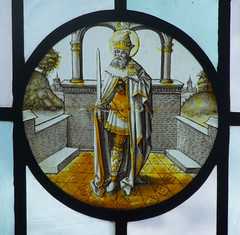 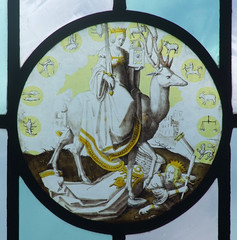 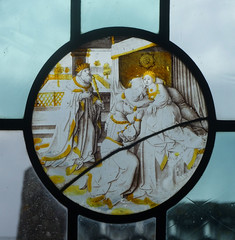 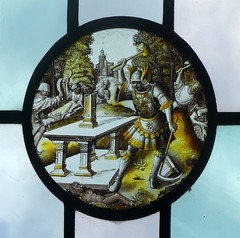 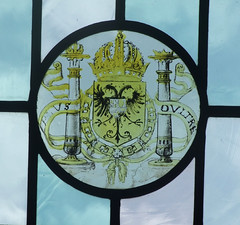 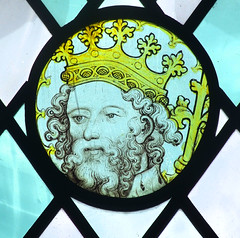 
The
roundels depict biblical scenes, mainly from the Old
Testament and the Apocrypha, but also allegorical
subjects, including the Triumph of Ecclesia (the Church)
over Synagogia (the Jewish tradition). This roundel also
features a zodiac sequence.
The
four roundels of the Evangelists are probably by
Robert Allen the Lowestoft-based porcelain
painter, or possibly even by Yarrington himself.
They're a bit mawkish. Their symbols, obviously
tame, look on adoringly like pets at their
masters as the four men sit there writing; but
the whole thing holds well together.
William Windham, the recipient of the grand
memorial on the nave wall, died in 1730 having
lost a limb in the defence of his country, which
obviously leaves us wanting to know more. There
are other Windam memorials, all well done.
All this apart, you come to Earsham for the glory
of the late 19th century Anglo-catholic revival.
Reginald Hallward's reredos features the
Adoration of the Magi as well as groups of
plump-cheeked, kitschy angels. Mortlock thought
well enough of it in the 1980s, seeing it
anticipate the work of Ninian Comper (who was
busy near to here at Eye, Lound and Barsham) but
today, in the early years of the 21st century, it
is just about in the very peak of modern
Christmas card fashion. It would be interesting
to know if Hallward used children from the
village as his models. |
|
 |
|
|
|


